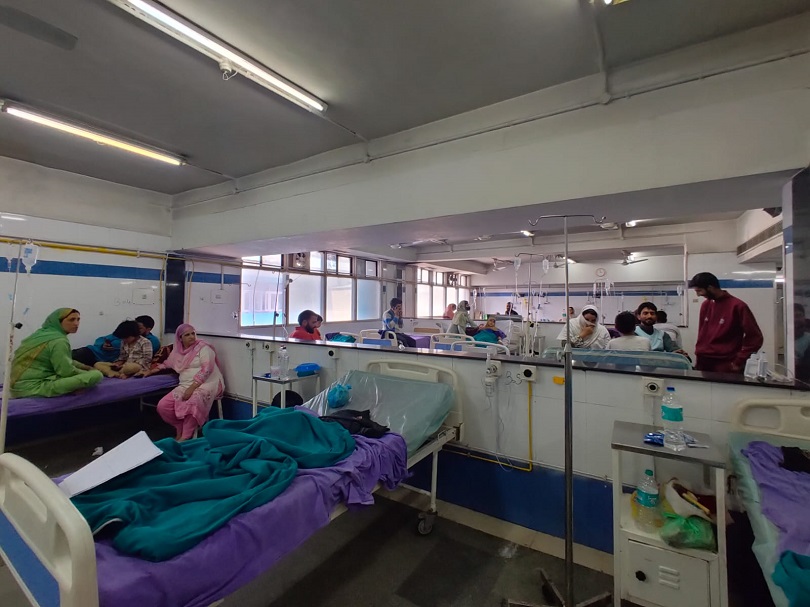
Srinagar- Jammu & Kashmir’s health care sector is battling a major crisis in the face of inadequate Human Resources for Health (HRH) as a latest analysis of key state-wise parameters of registered doctors, nurses and midwives revealed that the Union Territory has scored lower than the national average of 33.5 percent and World Health Organization’s (WHO) benchmark of 44.5 percent.
According to the Health Ministry Data, as per WHO’s recommendation of 44.5 HRH per 10,000 population, 12 out of 30 states in India have qualified the benchmark. However, J&K has failed to achieve the required score. The report said that analysis of key state-wise parameters of registered doctors and nurses and midwives per 10,000 population has observed that J&K has only scored 11.6 percent, substantially lower than the national average and WHO’s benchmark.
The report further pointed to the fact that despite the government sector being able to provide education for more than 60% of doctors, 50% of nurses and midwives in India were employed in the private sector, with public facilities in different states reporting high levels of vacancies against the sanctioned posts.
Based on the National Sample Survey Office (NSSO) 2018 data, the report said that nurse-to-doctor ratio in India was estimated to be 1.7:1, which is lower than the recommendation of 3:1 as per the Indian High Level Expert Group (HLEG).
Even though the nurse-to-doctor ratio in India was lower than the given recommendation, a large-scale difference in the ratio was found in J&K as there were less than one nurse per doctor in the Union Territory, prompting “a need to strike the right balance between allied health professionals and doctors”.
According to the data, J&K has the third lowest number of medical colleges in North India as UT had only 10 medical colleges during 2021-22. The report further added that J&K accounted for 1,147 UG seats per 1 lakh population in India and 837 PG seats per 1 lakh population during 2021-22.
It added that India had only 98 medical colleges in 1971–72, which reached to only 128 by 1990–91. The pace picked up and India witnessed 189 medical colleges in the next 10 years, i.e., by 2001. In 2011-12, the number of medical colleges, including private and government, was 335, which increased to 612 in 2021-22, observing an 83 per cent growth. The average annual growth of medical colleges from 2011-12 to 2021-22 was 5.9 per cent— the highest in the last five decades.
The report also mentioned that J&K accounted for 11.6 percent of doctors for every 10,000 population—more than WHO’s benchmark of 10 percent per 10,000 population.
While quoting Indian Nursing Council(INC) Annual Report 2021, the data said that India has 5,162 nursing institutes – private (87%) and government (13%). Approximately 60 percent of nursing institutes are concentrated in 5 States – Maharashtra (14%), Karnataka (12%) and Madhya Pradesh (9%), Uttar Pradesh (7%) and Tamil Nadu (7%).
Lowest number of institutes were in the North Eastern states of Bihar, J&K, Himachal Pradesh and Uttarakhand. J&K had only 34 nursing institutes in 2021 which accounted for only 1 percent of the National Average. As per the analysis, J&K has 17.1 (1 percent) nursing seats per 100,000 population during 2020-2021.
While pointing towards the density of Allied Healthcare Professionals per 10,000 population, the data analysis revealed that J&K’s share was higher than the national average as the UT’s share was 15.7 percent against 8.4 percent national average.
The Data analysis stated that the disparity in the availability of doctors would grow if remedial measures were not put in place. “This despite the fact that the government has tried to increase the number of medical seats at the state level to help cover the shortage of doctors through implementing various initiatives,” the analysis warned.
Follow this link to join our WhatsApp group: Join Now
Be Part of Quality Journalism |
Quality journalism takes a lot of time, money and hard work to produce and despite all the hardships we still do it. Our reporters and editors are working overtime in Kashmir and beyond to cover what you care about, break big stories, and expose injustices that can change lives. Today more people are reading Kashmir Observer than ever, but only a handful are paying while advertising revenues are falling fast. |
| ACT NOW |
| MONTHLY | Rs 100 | |
| YEARLY | Rs 1000 | |
| LIFETIME | Rs 10000 | |











